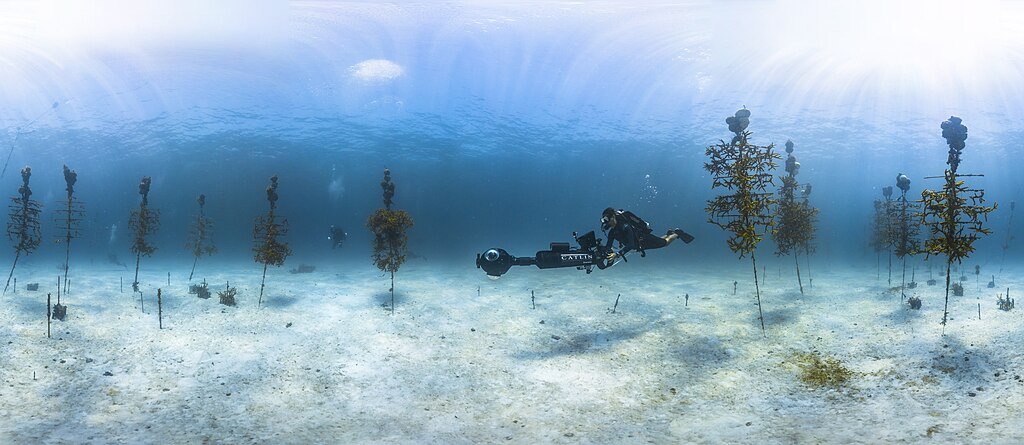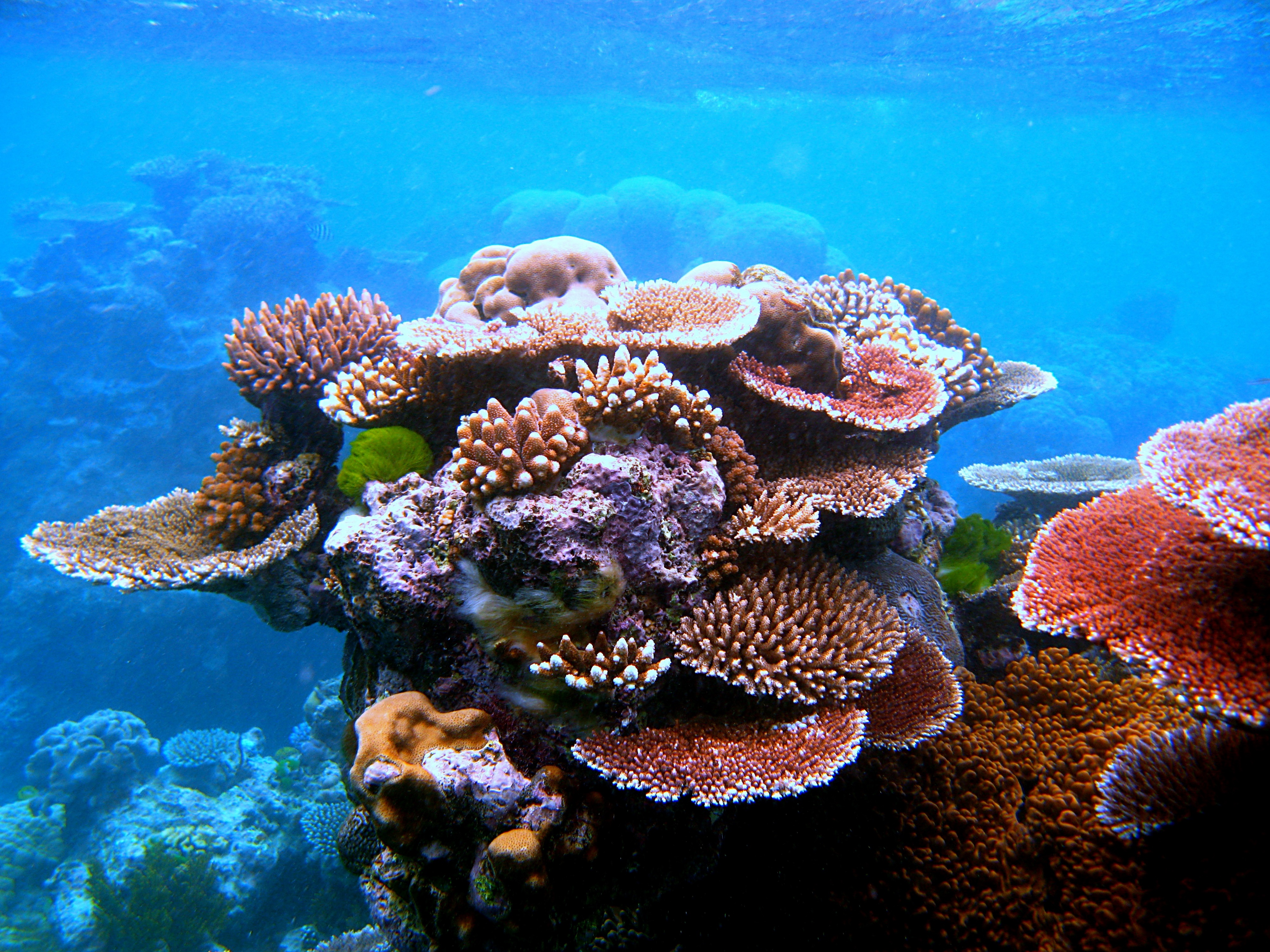
How Technology Can Assist Coral Reef Restoration
Coral reefs are beautiful, interesting, and incredibly important ecosystems. They occupy less than 1% of the ocean, yet are home to roughly 25% of the world’s marine life - over 4,000 species of fish.
Coral reefs generate billions of dollars each year; from tourism, to jewelry, to food, and even medicine. But I’m not here to talk about the ways that coral reefs help us, I want to focus on the ways we are helping them.
Corals are animals, not plants, which is a common misconception. They come in hard and soft varieties, and attach themselves to rocks to form a colony. These colonies are located in tropical locations near the equator, where the water is warm enough to sustain them, with the major reefs off the coasts of Australia, Indonesia, Philippines, Papua New Guinea, Fiji, and the Maldives.

U.S. Fish & Wildlife Service - Pacific Region's Photo credit: Jim Maragos/U.S. Fish and Wildlife Service, CC BY 2.0, via Wikimedia Commons
Corals are more fragile than most people realize, and can be affected heavily by stressors in their environment. They like warm water, but when the water temperature gets too hot, or the water too acidic, they go through a process called “coral bleaching.” This bleaching involves the coral expelling their natural algae into the water. Without the algae, the corals lose their color and become transparent, exposing their skeletons. At this stage the coral is not dead, but more fragile and susceptible to disease and possible starvation.
There are many stressors on coral, from the ones I mentioned above to issues caused from human activity; overfishing, which disrupts the ecological balance of the reef and harms biodiversity, other fishing practices like dynamite and cyanide poisoning, and damage from ships. Changing weather patterns, sediment runoff, and pollution are also dangers to coral reefs.
The Great Barrier Reef Foundation gives these facts about coral bleaching:
- Rising ocean temperatures caused by climate change is the primary cause of coral bleaching
- A temperature increase of just one degree Celsius for only four weeks can trigger bleaching
- Changes in water quality, increased sun exposure and extreme low tides can also cause corals to bleach

Vardhan Patankar, CC BY-SA 4.0, via Wikimedia Commons
What is coral reef restoration? This is a rather broad term that covers a range of conservation methods, but it boils down to helping rebuild and protect these valuable, vulnerable ecosystems.
There are many methods, including propagation, IVF (In vitro fertilization), assisted evolution, and acoustic enrichment.
Propagation

NOAA, Public domain, via Wikimedia Commons
Propagation is the act of taking a small bud, or a broken fragment, of coral and growing it in an underwater nursery. From there the pieces are returned to the reef and secured in place - with things such as cement, zip ties, and even nails.
However a new method has been developed by CoralTech called the CoralclipⓇ. It allows scientists and researchers to re-attach coral pieces to the reef without the need for chemical bonding agents. On their site, CoralTech says that “The design and verification of Coralclip (on our first 4,000 planted corals, August 2018-May 2019) is described in detail in our publication… Since then, the device has been used throughout the tourism partnership to plant 60,000 corals (October 2021) across 6 northern Great Barrier Reef sites.”
Coral IVF

National Marine Sanctuaries, Public domain, via Wikimedia Commons
Like propagation, this involves human assistance in growing corals. Corals have a mass reproduction event once a year where eggs and sperm are released into the water with the hope that they will create coral polyps that successfully attach themselves to the reef and grow. But of course, as is the case with life, that doesn’t always happen successfully.
Scientists collect the eggs and sperm and rear millions of baby corals, often in floating pools nurseries. They can also be raised in a lab, and are often studied, which is called Coral Aquaculture.
Assisted Evolution
John A. Burt, CC BY-SA 4.0, via Wikimedia Commons
I’m going to focus on assisted evolution in two areas: coral and algae.
Assisted coral evolution takes two paths, stress conditioning and selective breeding. With climate change marching on, some scientists have moved from prevention to adaptation. Instead of trying to control the many coral stressors, they’re trying to make the corals less vulnerable to those stressors. In a lab, they expose the coral to almost-lethal conditions (water temperature, water acidity, etc.) to boost their tolerance. The hope is that those that survive will pass those survival traits on to their offspring.
Selective breeding for coral involves cross breeding different coral species to create a more hardy, stress resistant hybrid.
There has been success in making a more heat tolerant algae. Coral and algae are symbiotic, the coral gives the algae a home, and the algae photosynthesize and provide food for the coral. But, when water temperatures rise, or the water becomes too acidic, the algae leaves (coral bleaching). The hope with heat tolerant algae is that when those stressors appear, they will weather the storm, so to speak.
The process was first started in Saudi Arabia in 2017 and was replicated successfully in Australia in 2020 by the University of Melbourne, CSIRO and the Australian Institute of Marine Science (AIMS). You can read their article here.
Acoustic Enrichment
This method involves taking recordings of a healthy reef (surprisingly noisy places) and playing them through underwater speakers in degraded reefs.
We are proud to see the HydroMoth (by Open Acoustic Devices) used in one of these research studies.
The team from the University of Bristol, and Professor Steve Simpson, along with the University of Exeter, conducted a study in the Maldives. They recorded the sounds of a bustling coral reef using a HydroMoth (among other hydrophones) and an underwater camera. After syncing the two, they were able to isolate individual fish and the noises they made.
In a tank they placed coral polyps, and used the recordings to see what species of fish made sounds that attracted coral polyps to land and colonize.
They published in their article that “Acoustic enrichment increased the abundance of juvenile fishes across all major trophic guilds. Comprehensive whole-community surveys after 40 days revealed that there were significantly more herbivores, omnivores, planktivores, invertivores and piscivores on acoustically enriched reefs than on acoustically unmanipulated reefs.”
Technology
There are some awesome, creative, and innovative technologies being used for coral reef restoration and conservation. From Biorocks to 3D printing, let’s dive in. Pun absolutely intended.
Biorocks
Though this may look like an art project or the entrance to a villain’s underwater lair, it is neither. These “Biorocks,” as they have been called, are steel structures with a low voltage current of electricity running through them.
Created by marine scientist Wolf Hilbertz, and marine biologist Thomas J. Goreau, it was patented in 1979. The two discovered that running this electric current through the water causes a chemical reaction that coats the steel in limestone minerals. These minerals are similar to the ones produced by young coral. The video above shows the installation of a Biorock, and the results after six months.
3D Printing
3D printing is making waves in coral reef conversation. Not only is it allowing scientists to construct submersible structures (shown in the video above), it's also been used in labs to simulate the movement of loose rubble. This is important because loose rubble can damage reefs if it is thrown around by the waves, and because coral polyps can settle on the rubble and can be damaged when it moves.
Brightly colored, 3D printed, pieces of coral are placed within the reef, and their positions are monitored over time to see how far they are moved by the waves. Other loose pieces within the reef are often secured down with zip ties or other materials.
Hydrophones

Photo credit to Ben Williams
Hydrophones are designed to detect acoustic signals underwater. The National Ocean Service explains how they work on their website.
“Most hydrophones are based on a special property of certain ceramics that produces a small electrical current when subjected to changes in underwater pressure. When submerged in the ocean, a ceramic hydrophone produces small-voltage signals over a wide range of frequencies as it is exposed to underwater sounds emanating from any direction. By amplifying and recording these electrical signals, hydrophones measure ocean sounds with great precision.”
This ‘special property’ of certain ceramics is called the piezoelectric effect. Fun fact for our Moth lovers: the HydroMoth uses a different type of microphone. It utilizes a silicon MEMS (micro-electromechanical system) instead.
PhD student at UCL and conservationist Ben Williams uses not only the HydroMoth, but other hydrophones in his projects. One project focuses on the growing scientific effort around the Sheba, with MARS, using the Mars Assisted Reef Restoration System (MARRS), are working to restore Indonesia’s Salisi’ Besar Hope Reef. They are using what MARS calls a Reef Star, which acts like the Biorocks mentioned above, but without electricity. Instead they cover it with resin and coral sand before attaching the coral pieces.
The acoustics research is being led by Ben Williams. He and his team use sound recordings to monitor the progress of these projects. Listening to each recording and identifying fish sounds is a labor- intensive process that monopolizes a researcher’s time. To expedite this, they taught an AI how to distinguish between the soundscapes of a healthy coral reef, and that of a degraded one, just like how researchers can teach an AI to recognize and identify species through camera traps, as mentioned in a previous article. Some of Williams’s recordings can be found here.
Camera Traps

OIST from Onna Village, Japan, CC BY 2.0, via Wikimedia Commons
Camera traps are set up to capture pictures or video. Usually they are in a standby mode until they are triggered by movement. Camera traps can be integrated with AI to help identify certain species. Most often camera traps are used by researchers to monitor population, or track progress for a conservation project.
How can you contribute?
There are some fun conservation projects taking place at the moment.
4Ocean, a company that has pulled more than thirty-four million pounds of trash from the ocean, rivers, and coastlines, has released a new line of their bracelets for the restoration of the coral reef off the coast of Mo'orea Island in French Polynesia.
With the purchase of one bracelet, 4Ocean will remove five pounds of trash from the oceans, river, and coastlines, and also plant one coral fragment from any of the five offered coral species (each coral has a corresponding color bracelet): Pocillopora Verrucosa (Pink), Acropora Grisea (Glacier) , Acropora Retusa (Green), Acropora Muricata (Blue), and Acropora Globiceps (Glow/white).

Toby Hudson, CC BY-SA 3.0, via Wikimedia Commons
SeaTrees by Sustainable Surf, is an organization that plants things - things like mangrove seatrees, and coral seatrees. They also restore kelp forests and seagrass. They have planted over 3.6 million seatrees.
For $25 each, you can have SeaTrees plant a piece of coral for you off the coast of the Nusa Penida region of Bali, Indonesia. The donation is tax-deductible too, so there’s a bonus.

